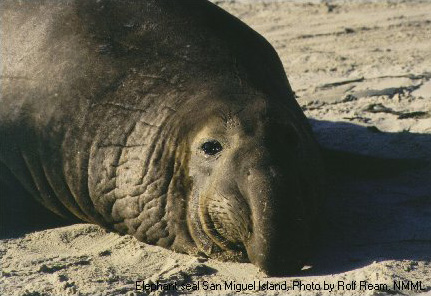Deepseawaters Calendar - January
By Month - Feb | March |april | May | June | Aug | Sep | Oct | Nov | Dec
Gray whales (Eschrichtius robustus) migrate south through the Monterey Bay, Gulf of the Farallones, and Cordell Bank National Marine Sanctuaries. From December through February, the whales swim along the coastline and may be visible from shore as they head for the warm waters of Mexico's west coast lagoons for calving and mating.
p>January is the peak month for Northern elephant seal pup births in the Monterey Bay and Gulf of the Farallones National Marine Sanctuaries. Females give birth to a single pup within a week of hauling out on the beach. Pups will be nursed for three to four weeks before weaning. In Cordell Bank National Marine Sanctuary, rockfish spawning peaks this month.
Northern elephant seal (Mirounga augustirostris) pupping and breeding season on San Miguel Island in Channel Islands continues through February. On Anacapa and Santa Barbara Islands, California Brown Pelicans (Pelecanus occidentalis californicus) begin nesting through the month of February. The seals also breed on Southeast Farallon Islands and at nearby Pt. Reyes National Seashore.
Hammerhead sharks and spotted rays school around the East and West Flower Garden Banks Sanctuary, through early April. In mid January, North Atlantic right whale return to Cape Cod Bay and the southern end of the Stellwagen Bank Sanctuary to feed on early bloom of copepods. Winter gull migration begins. Female northern right whales calve off the coast of Georgia and North Florida, Gray's Reef Sanctuary. Alcids, such as razorbills and dovekies, overwinter at Stellwagen Bank National Marine Sanctuary.
A portion of the critically endangered North Atlantic right whale population returns to Cape Cod Bay and Stellwagen Bank region to feed on patches of copepods. The winter months are excellent for tidepooling in the Channel Islands National Marine Sanctuary because afternoon low tides expose marine algae and invertebrates. The low tides which began in November continue though February. Minus tides in the Gulf of the Farallones National Marine Sanctuary permit intensive intertidal algae and invertebrate surveys at S.E. Farallon Island.
 Deep Sea Crabs
Deep Sea Crabs